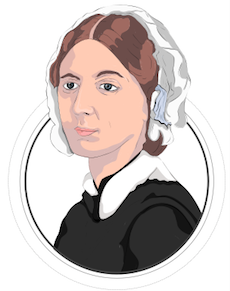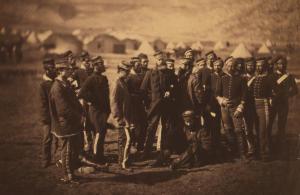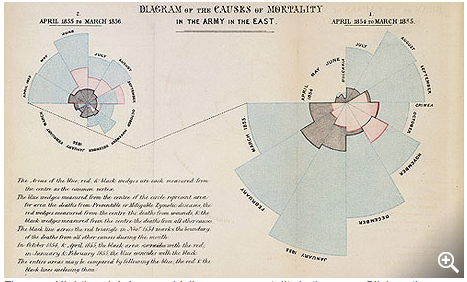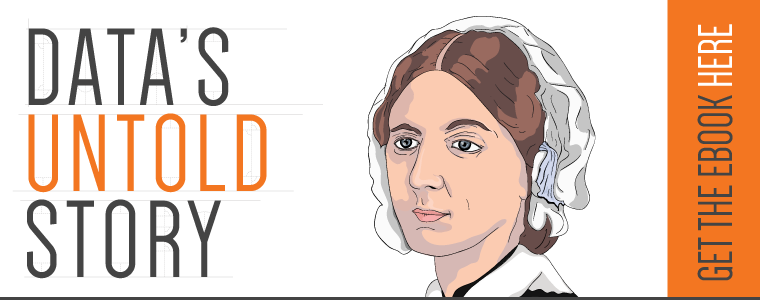Today, data visualizations are everywhere. You can find data visualizations for almost anything: Game of Thrones character arcs, How Americans Die, baseball, and whether April showers really bring May flowers. This wasn’t always the case. One of the pioneers of data visualization was Florence Nightingale. While remembered for her nursing abilities, she was an important statistician, with data visualization skills that inspired massive social change.
 In her day, Florence Nightingale was revered. Queen Victoria famously wanted her for the Cabinet, saying of her, “Such a head! I wish we had her at the War Office.” She was a fighter, arguing for what she believed in and forcing the world to change when made to understand the facts she presented. Since then, her role as a fierce data journalist, feminist, and war nurse has been obscured by a fuzzier vision of the Lady with the Lamp.
In her day, Florence Nightingale was revered. Queen Victoria famously wanted her for the Cabinet, saying of her, “Such a head! I wish we had her at the War Office.” She was a fighter, arguing for what she believed in and forcing the world to change when made to understand the facts she presented. Since then, her role as a fierce data journalist, feminist, and war nurse has been obscured by a fuzzier vision of the Lady with the Lamp.
Who was she?
She was born into wealth in 1820. Educated and passionate, Nightingale balked at the idea of the traditional life, refusing to become a wife to any of her suitors. At 17, she announced she wanted to be a nurse. This was a household scandal, nursing was considered a job for servants. It wasn’t until 1853 that she won independence from the life her family expected of her, becoming Superintendent of the Hospital for Invalid Women in Harley Street. One year later, she took the opportunity to abandon expectation forever.
A Nation at War Needs a War Nurse
 The Crimean War was raging, and the death toll of British soldiers was rising, often pointlessly. This is the conflict immortalized in “The Charge of the Light Brigade.” Mismanagement was everywhere. Soldiers only had summer uniforms, not enough kits, and in the field hospitals, the death rate was so astounding it was a public disgrace. Florence Nightingale was friends with the Secretary of War, Sidney Herbert, and in 1854 he asked her to create a staff of female nurses to come and help. Women had never been sent before to provide support during a foreign war. “There is but one person in England I know of who would be capable of organizing and superintending such a scheme…” he wrote.
The Crimean War was raging, and the death toll of British soldiers was rising, often pointlessly. This is the conflict immortalized in “The Charge of the Light Brigade.” Mismanagement was everywhere. Soldiers only had summer uniforms, not enough kits, and in the field hospitals, the death rate was so astounding it was a public disgrace. Florence Nightingale was friends with the Secretary of War, Sidney Herbert, and in 1854 he asked her to create a staff of female nurses to come and help. Women had never been sent before to provide support during a foreign war. “There is but one person in England I know of who would be capable of organizing and superintending such a scheme…” he wrote.
Nightingale accepted the post and was stationed to the hospital at Scutari with 38 nurses. Once she arrived with her team, she quickly realized the horror of the situation, writing:
There were no vessels for water or utensils of any kind; no soap, towels, or clothes, no hospital clothes; the men lying in their uniforms, stiff with gore and covered with filth to a degree and of a kind no one could write about; their persons covered with vermin. We have not seen a drop of milk, and the bread is extremely sour. The butter is most filthy; it is Irish butter in a state of decomposition; and the meat is more like moist leather than food. Potatoes we are waiting for, until they arrive from France.
Men were arriving, injured from war, then dying of preventable diseases. They were packed tightly into unventilated hospital space above defective sewers. Soldiers lay in their clothes, on muddy floors. During Nightingale’s first winter at the hospital, 4,077 soldiers died. Illness like typhus, typhoid, cholera, and dysentery killed ten times more men than actual battle wounds.
Florence Nightingale refused to accept this horror. She ordered in fresh food and clean supplies. She and her staff of nurses stalked the halls at night, working to clean up unsanitary conditions. During this time, Nightingale kept meticulous records regarding conditions, and the deaths. She worked herself into illness, brucellosis, a chronic disease she suffered from for the rest of her life. This dedication earned her immortality as “The Lady with the Lamp.” There are paintings, poems, plays, and movies about her.
The Angry Statistician
Brucellosis sent Nightingale home to England, where she was supposed to stay in her bed. She was haunted by loss, and determined to prevent future deaths. She persuaded the Queen to appoint a Royal Commission on the Army medical department. She wrote reports hundreds of pages long, and published “Mortality of the British Army.”
Nightingale wanted to present the “loss of an army” in a way that could be immediately understood. She worked with William Farr, one of the first epidemiologists to compile tables of statistics that tracked where people had died, and why. She found that even during peacetime, soldiers were dying young far more frequently than the civilian population.
Nightingale needed to convey this information in a way that it would be understood immediately. If Parliament saw how their army was dying, she knew they would be forced to act. Even as her mentor advised her that “statistics should be the driest of all reading” she worried that the dryness would stand in the way of comprehension and action.
Nightingale disregarded the advice of her mentor. She transformed her reports with bar graphs (which had only recently been invented) and created a brand new chart, the coxcomb, to show numbers of deaths by month along with their causes. With just a glance, anyone can see how blue, representing totally preventable deaths from disease, dominates the space.
Giving people a way to visually understand data created an avalanche of reform in Nightingale’s time. By showing how high mortality rates were caused by sanitation issues, she was able to spearhead reform in British army hospitals and civilian hospitals. She used her statistics to prove that British slums needed to be cleaned to save the life of the impoverished population.
Nightingale was one of the pioneers of visual analysis. Her methods were new – the “Nightingale Rose” or what she called the coxcomb is still being used today.
Her data analysis changed the world:
- Nightingale Wards – in their time, changed the layout of hospital wards to be open and clean, arranged patients to be visible to doctors and staff
- Established nursing schools – created standards for the profession and increased its esteem in society
- Public sanitation – participated in the successful argument that proper sewage was necessary to save lives
- Establishment of hospitals – new hospitals sprang up to use her methods throughout the world and countless organizations bear her name today
- Evidence based medical practices – she created the first model for consistent statistical analysis in hospitals
Florence Nightingale didn’t collect data just to have it, and she wasn’t merely good with it. She knew none of her information could do anything whatsoever if people couldn’t understand it. Nightingale witnessed thousands of pointless deaths. With her charts, the men who’d died thousands of miles away became visible.


